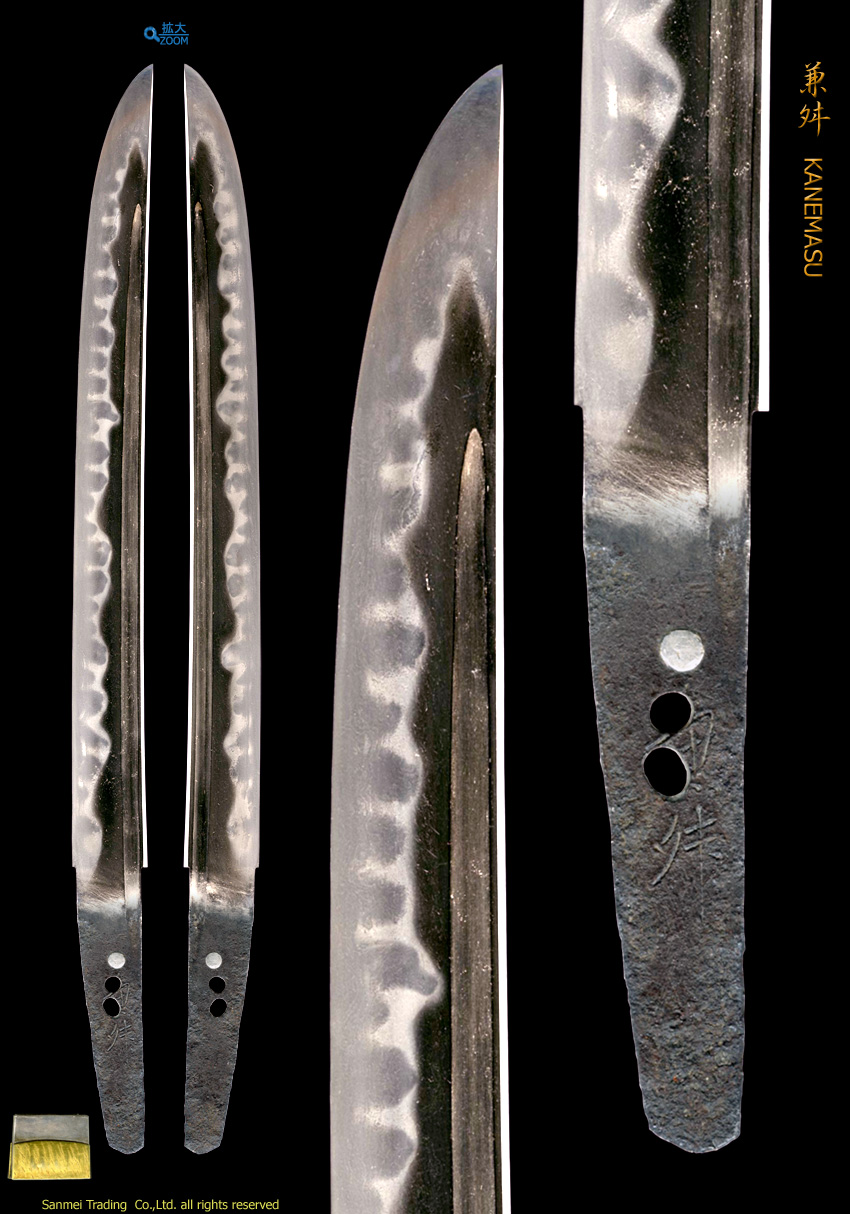Length of cutting edge 29.0cm Curvature 0.2cm Width of base 27.1mm Thickness of base 5.5mm
Forging(Hada): Forging is fine ITAME and MOKUME hada with partial flowing MASAME indication.The surface is covered with sparkling Ji-nie glitter indicating whitish reflection so called "Shirake-utsuri".
Temper(Hamon): Hamon forms broad-minded, varies in shape of Gunome-midare mixing with waisted tassel-shape, box-like, pointed head or slanted clove outline which is in different angles. Gunome ravine glows with thick sparkling hard metal granules of Nie where is active with curved mark of KINSUJI and SUNAGASHI. Some YOU of floating quench dot appears in the interior of temper.
Temper of tip(Boshi): Temper of tip is strong hard metal granule base,irregular outline with Hakikake/Niju-ha thick lines of Nie then small circle deeply turns back to form like a profile of Jizo stature.
Tang(Nakago): Nakago is in UBU original. Higaki crossing file marks. Three peg holes (one is filled). Single-bevelled (Kurijiri) heel shape. Back ridge of Nakago is flat. The signature in front is two character that reads KANEMASU 兼舛.
Mino province was one of the five major native sword places of Yamato, Yamashiro, Bizen, Soushu and Mino.
Mino tradition had undergone a great change through the medieval battle ages that gave practical martial usage and functional beauty.
Sword makers in Mino formed self-governing groups "Kajiza" 鍛冶座 under guardian divine protection of Kasuga-jinja shrine and got orders from the major military commanders or powerful clans to enjoy joint buying of fine steel or quality control to meet with their requirement.
On the latter half of Muromachi period, most of Mino sword makers had started gathering to Seki town and formed Seven Seki-groups that were Zenjo 善定派(兼吉),Muroya 室屋派(兼在),Ryoken 良賢派(兼行), Nara 奈良派(兼常),Tokunaga 得永派(兼弘),San'ami 三阿弥派(兼則),Tokuin 得印派(兼安)then became to see the golden age both of Mino and Bizen tradition in the matchless two greatest authorities.
According to a reference Mino-to Taikan, the subject maker KANEMASU 兼舛 belonged to Nara 奈良派 group in Seki during Tenbun-Eiroku era (1532-69).
The subject cool Tanto was equipped as the supplementary usage for the long Katana/Tachi sword against the armored worrier, which was suitably designed for stabbing into the gap of armor suit or cut a neck through a opening of helmet. Workmanship clearly states Mino tradition during early 16th C., almost 500 years passage.
Condition scale: very good - good (using a scale of mint-excellent-very good-good-fair-poor).
Double layers(lower-silver foiled/upper-gold foiled) Habaki collar, Preserved in Shirasaya plain wood mounting
reference data :
Honma Kunzan/Ishii Masakuni, Nihonto Meikan, Yuzankaku, 1975
Sugiura Yoshiyuki/Suzuki Takuo, Muromachi-ki Mino-to no Kenkyu, Ribun shuppan, 2006
Tokuno Kazuo, Mino-to Taikan, Otsuka kougeisha, 1975


